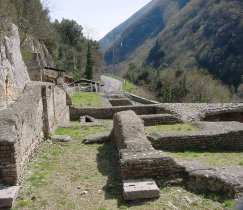From the origins to St. Benedict's arrive
In ancient times settlers of the area were the Aequi, an Italic people. In 304 BCE they were won by the Romans, who subsequently introduced their civilization and took advantage of the waters of the Aniene river.
During the Roman empire, Subiaco enjoyed a time of great prosperity. Nero built a villa with the famous artificial lakes in which the town was reflected. Unfortunately these disappeared when the dam wall across the river broke. After the fall of the Roman Empire, the villa and the town were abandoned, becoming almost forgotten ruins.
In 497 (ca.) Benedict begins to live as a hermit in in a cave in Mount Taleo where he spent three years in solitude and prayer. Today this cave is called the "Speco Sacro" -- the Holy Grotto. During this time his fame as a saintly man grew and many came to see him. Benedict founds a monastic order having strict links with the Bishop of Rome, in contrast with the then prevailing Basilian order which had strong ties with the Eastern Roman Empire (the Western Roman Empire had ended in 473). He founded twelve monasteries around Subiaco and in 529 he leaves Subiaco to found a new monastery in Montecassino.
The one at the grotto seems to have had but a short existence; we find a record of its renovation in 854. Abbot John V, created cardinal by Gregory VII, made the grotto the terminus of a yearly procession, built a new road, and had the altars reconsecrated.
Surroundings
-
The Sacro Speco

An impressive complex of buildings which almost looks as if it is one with the surrounding rock...
To know more
-
Rocca Pia
Built on the place where Callisto II Borgia's Castle was situated...
-
Church of St.Peter
It was built on the rests of a roman villa...
Tivoli's attractions

Patrocinio Comune di Tivoli
Assessorato al Turismo



